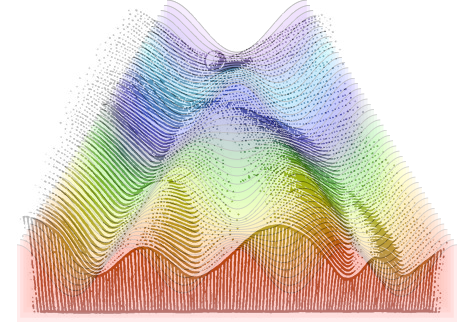
|
|
|
Gemma Anderson-TempiniRe-imagining Waddington's epigenetic landscape: Drawing the marble and the topography Gemma Anderson-Tempini Falmouth University, UK e-mail: G.E.Anderson@exeter.ac.uk Waddington was the first scientist to use the term “epigenetics” to conceptualise the interaction between genetic and environmental factors in development, and introduced the idea of the epigenetic landscape as a metaphor for the possible trajectories of development; this concept, if in a slightly modified sense, is widely used in theoretical biology to this day. He is perhaps best known for the images he made in collaboration with artists of the epigenetic landscape as a complex topography down which a marble can roll. The image provides a ‘a visual depiction of a set of developmental choices that is faced by a cell in the embryo, expressing the way these relations shape and channel development over time’ (Slack, 2002:893; see also Hall, 1992:119).
Waddington’s diagrams have been used in many ways. While they are most often interpreted as referring to the development of a cell, there are other possible applications. The images, at any rate, lend themselves to representing a diverse set of processes sharing a few core features typical of a wide range of biological processes: a forking pathway in which a decision at each fork irreversibly constrains future choices, and a landscape itself subject to change over time. As well as cells, tissues and whole organisms, the image could in principle be applied to a macromolecule or even an evolving lineage.
This contribution will reconsider and extend Waddington’s “epigenetic landscape” through a number of case studies and practical activities to create and extend versions of this representation and to present drawing as a pathway to a new dynamic representation of living processes at the molecular, cellular and organismal scale. Our case studies (Anderson-Tempini and Dupré, 2023) offer examples of adaptations of Waddington’s landscape that stimulate visual thought and enable us to contemplate biological processes in new ways. The epigenetic/developmental/homeorhetic landscape we conceive is one of life unfolding over time. We are adapting and evolving Waddington’s concept of the epigenetic landscape as a tool crafted at the intersection of art and science. To paraphrase Waddington, his artful representation helps to “loosen the joints of the scientist’s imagination”, creating a space for the associative play required to introduce new concepts in theory formation (Waddington, 1968).
|

